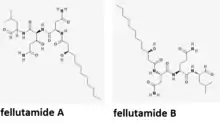Fellutamide
Fellutamide A and B are tripeptide derivatives from Penicillium fellutanum and other fungi. They are potent proteasome inhibitor that stimulates nerve growth factor synthesis in vitro.[1][2] It strongly inhibits the growth of the tuberculosis-causing bacterium Mycobacterium tuberculosis.[3] Its biosynthetic pathway has been determined in the filamentous fungus Aspergillus nidulans.[4]

Fellutamide A and B
See also
References
- Hines J, Groll M, Fahnestock M, Crews CM (May 2008). "Proteasome inhibition by fellutamide B induces nerve growth factor synthesis". Chemistry & Biology. 15 (5): 501–12. doi:10.1016/j.chembiol.2008.03.020. PMC 2485210. PMID 18482702.
- Yamaguchi K, Tsuji T, Wakuri S, Yazawa K, Kondo K, Shigemori H, Kobayashi J (February 1993). "Stimulation of nerve growth factor synthesis and secretion by fellutamide A in vitro". Bioscience, Biotechnology, and Biochemistry. 57 (2): 195–9. doi:10.1271/bbb.57.195. PMID 7763492.
- Lin G, Li D, Chidawanyika T, Nathan C, Li H (September 2010). "Fellutamide B is a potent inhibitor of the Mycobacterium tuberculosis proteasome". Archives of Biochemistry and Biophysics. 501 (2): 214–20. doi:10.1016/j.abb.2010.06.009. PMC 2930046. PMID 20558127.
- Yeh HH, Ahuja M, Chiang YM, Oakley CE, Moore S, Yoon O, Hajovsky H, Bok JW, Keller NP, Wang CC, Oakley BR (August 2016). "Resistance Gene-Guided Genome Mining: Serial Promoter Exchanges in Aspergillus nidulans Reveal the Biosynthetic Pathway for Fellutamide B, a Proteasome Inhibitor". ACS Chemical Biology. 11 (8): 2275–84. doi:10.1021/acschembio.6b00213. PMC 6457343. PMID 27294372.
This article is issued from Wikipedia. The text is licensed under Creative Commons - Attribution - Sharealike. Additional terms may apply for the media files.